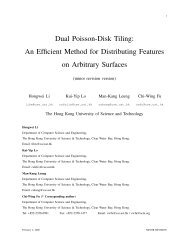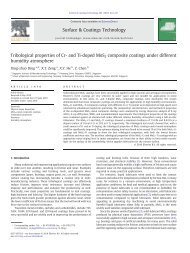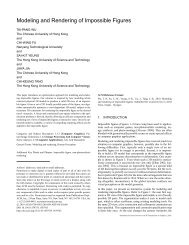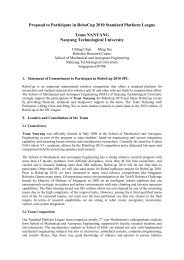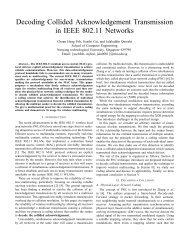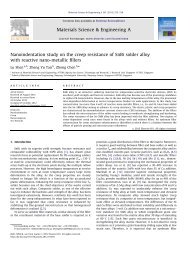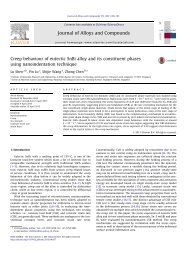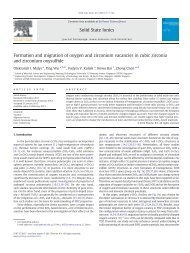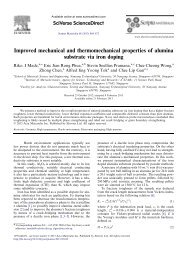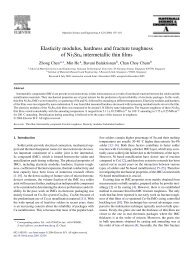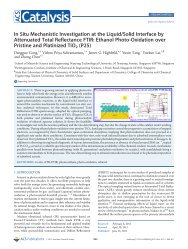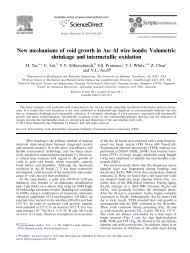Growth of Intermetallic Compounds in Thermosonic Copper Wire ...
Growth of Intermetallic Compounds in Thermosonic Copper Wire ...
Growth of Intermetallic Compounds in Thermosonic Copper Wire ...
Create successful ePaper yourself
Turn your PDF publications into a flip-book with our unique Google optimized e-Paper software.
128<br />
Fig. 7. Cross-sectional BSE SEM images <strong>of</strong> copper ball/Al metallization<br />
<strong>in</strong>terfaces after ag<strong>in</strong>g at 250°C for: (a) 1 h; (b) 25 h; (c) 100 h;<br />
and (d) 169 h. Al metallization th<strong>in</strong>ned with <strong>in</strong>creas<strong>in</strong>g time and<br />
disappeared after 169 h.<br />
with thermal treatment. Alum<strong>in</strong>um metallization<br />
was almost consumed after only 16 h.<br />
In a solid-state reaction analysis, the thickness x<br />
<strong>of</strong> IMCs at ag<strong>in</strong>g time t was estimated us<strong>in</strong>g the<br />
follow<strong>in</strong>g equation 15 :<br />
x x1 ¼ ðKtÞ 1=n ; (1)<br />
where K is the growth rate constant, x 1 is a constant<br />
related to the <strong>in</strong>itial IMC thickness, and n is the<br />
time <strong>in</strong>dex.<br />
The magnitude <strong>of</strong> the growth rate constant <strong>of</strong><br />
IMCs changes for different types <strong>of</strong> Cu-Al IMCs; it<br />
also depends on the neighbor<strong>in</strong>g phases, which<br />
supply additional Cu and/or Al for cont<strong>in</strong>ued compound<br />
formation. However, it is extremely difficult<br />
to measure the thickness <strong>of</strong> each <strong>in</strong>dividual IMC<br />
layer, as they <strong>in</strong>tertw<strong>in</strong>e with each other. Therefore,<br />
a comb<strong>in</strong>ed growth rate constant and activation<br />
energy for all potential Cu-Al IMCs formed <strong>in</strong> bonds<br />
were <strong>in</strong>troduced. Figure 9 shows the thickness <strong>of</strong><br />
Xu, Liu, Silberschmidt, and Chen<br />
Fig. 8. Cross-sectional BSE SEM images <strong>of</strong> Cu-Al samples aged at<br />
300°C for: (a) 1 h; (b) 4 h; (c) 9 h; and (d) 16 h.<br />
Cu-Al IMCs for samples aged for various times at<br />
200°C, 250°C, and 300°C. In general, the solid-state<br />
growth <strong>of</strong> IMCs can follow l<strong>in</strong>ear or parabolic<br />
growth k<strong>in</strong>etics. L<strong>in</strong>ear growth implies that the<br />
growth rate is limited by the reaction rate at growth<br />
sites. In contrast, parabolic growth implies that the<br />
growth is controlled by diffusion. It is obvious from<br />
Fig. 9 that the growth <strong>of</strong> IMCs follows a parabolic<br />
law (n = 2), suggest<strong>in</strong>g that the Cu-Al IMCs growth<br />
dur<strong>in</strong>g thermal ag<strong>in</strong>g is a diffusion-controlled process.<br />
Cu-Al IMCs grew faster at the earlier stage <strong>of</strong><br />
ag<strong>in</strong>g, and the process was more sensitive to the<br />
ag<strong>in</strong>g temperature than to the ag<strong>in</strong>g time. The<br />
growth rate constants for Cu-Al IMCs (Table II)<br />
were calculated from the fitted parabolas <strong>in</strong> Fig. 9.<br />
Accord<strong>in</strong>g to the classic k<strong>in</strong>etic theory, the value<br />
<strong>of</strong> K is characterized by the temperature and activation<br />
energy, and it can be given by the Arrhenius<br />
equation 17,23,24 :<br />
K ¼ K0 exp<br />
Q<br />
RT<br />
; (2)



